The Castle of Vélez Blanco is the most imposing fortress in Almería, after the Alcazaba of the capital. Originally from the 16th century, its Renaissance decoration was sold, dismantled and moved to the Metropolitan Museum in New York between 1903 and 1964. We will tell you why it happened, what its journey was like and some more stories about the castle.
What you will find here
THE CONSTRUCTION OF THE CASTLE OF VÉLEZ BLANCO
We are located in the north of Almería, territory of the Nasrid Kingdom of Granada during the late Middle Ages. After the conquest of Granada it was necessary to strengthen the area and give it authority. This is the time of the construction of the castle of Vélez Blanco.
The Catholic Monarchs made an agreement with the Fajardos. These Murcian nobles ceded the Adelantamiento of Murcia, Cartagena and were granted the towns of Vélez el Blanco, Vélez el Rubio, Cuevas and Portilla. Pedro Fajardo Chacón received the title of Marquis of Vélez in 1503 and, three years later, he began the construction of the new castle in Vélez Blanco on the site of the old Muslim fortress. The work on the palace-fortress was completed in 1515, following the guidelines of the medieval fortresses and the Renaissance models of decoration for the palatial part.
The castle of Vélez is built with tuff or travertine ashlars and limestone. Both sedimentary rocks were obtained from nearby quarries. Probably from the area known as the quarries and from the entrance to the village of Vélez Blanco.
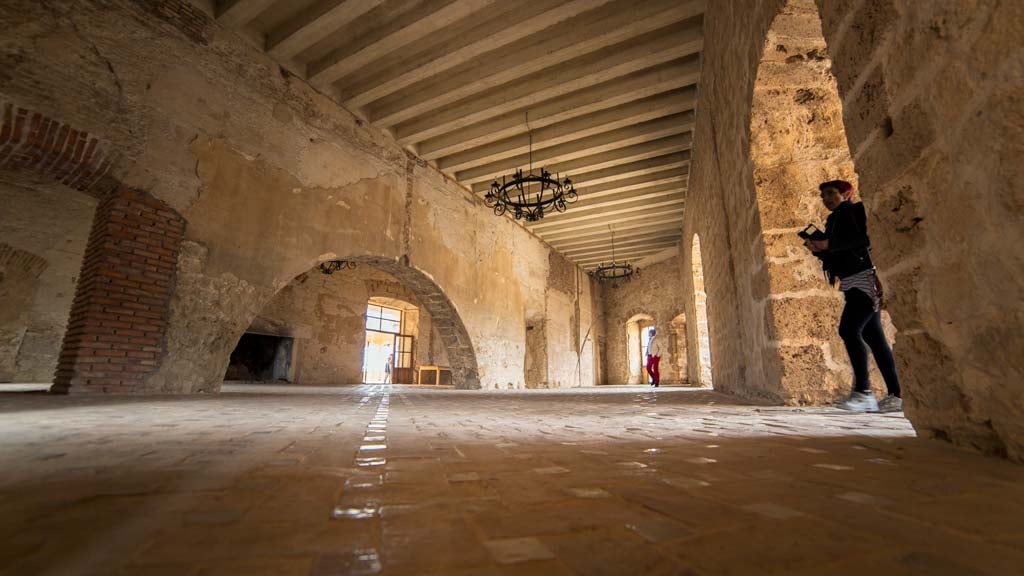
Halls of the castle of Velez Blanco where the rammed earth walls of the previous medieval castle still remain (© Turismo Andaluz. www.andalucia.org).
THE MARQUES OF LOS VÉLEZ
Originating from Galicia, the Fajardo family was a lineage with an important presence in the frontier struggles between Christians and Muslims between the 14th and 15th centuries. They were responsible for defending the Murcian coastline against the incursions and threats of the Berbers from North Africa. A large part of their income came from the alum mines of Mazarrón (in Murcia), jurisdictional taxes and livestock farming.
They formed an important and extensive lordship with the towns of Molina de Segura, Molina, Mula, Priego, Alhama and Librilla in the kingdom of Murcia. Later, with the incorporation of the kingdom of Granada into the crown of Castile, their lordship increased considerably. A large part of the province of Almería came under their control as a result of donations, inheritances and purchases. In the north Vélez el Rubio, Vélez el Blanco and in the Almanzora valley: Cuevas, Portilla, Oria, Cantoria, Partaloba, Albox, Albanchez, Benitagla and Zurgena.
The coat of arms includes three nettle bushes on three mountains and some sea waves, probably originating from Ortigueira (La Coruña). It was later adopted by the towns of Vélez Blanco, Vélez Rubio and, part of it, in the towns of Cantoria, Arboleas, Albox and Cuevas.
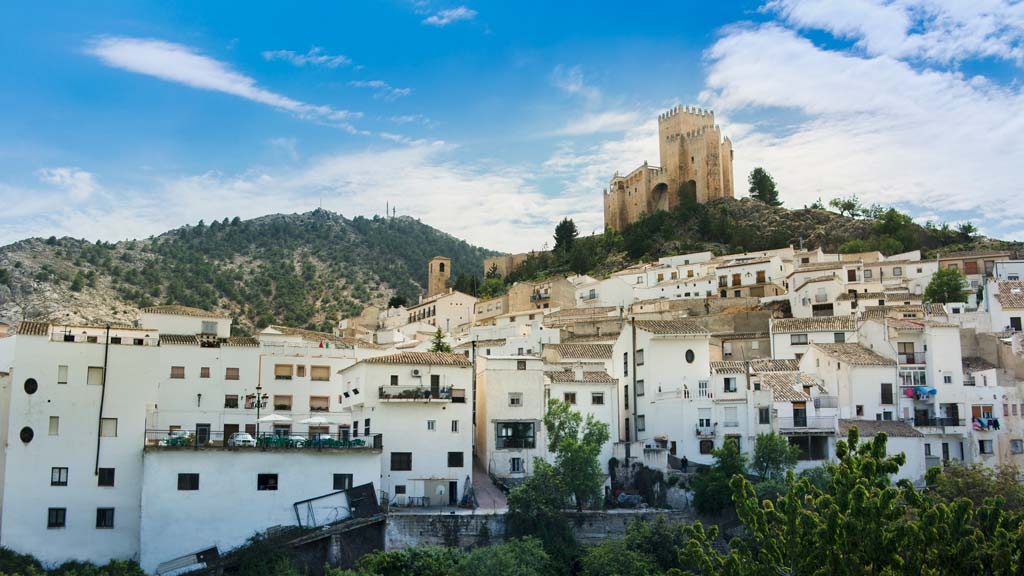
The castle of Velez Blanco dominating the territory (© Turismo Andaluz).
THE PATIO OF THE CASTLE OF VÉLEZ BLANCO
Renaissance decoration was found on all four sides:
- One side of the keep with the coat of arms of D. Pedro Fajardo Chacón (1478-1546).
- The wall with 6 profusely decorated windows.
- The high gallery that corresponded to the belvedere.
- The double gallery (high and low) which gave access to the Triumphal and Mythology halls.
Except for the keep, the three sides were completed with a cornice with gargoyles and topped with a balustradeof which some fragments remain. The material used was Macael marble. The decoration on capitals, columns, cornice, jambs and panels was completed with heraldic coats of arms, candelieri, female figures, winged and monstrous animals, typical of the refined taste of the artists and lords of the time.
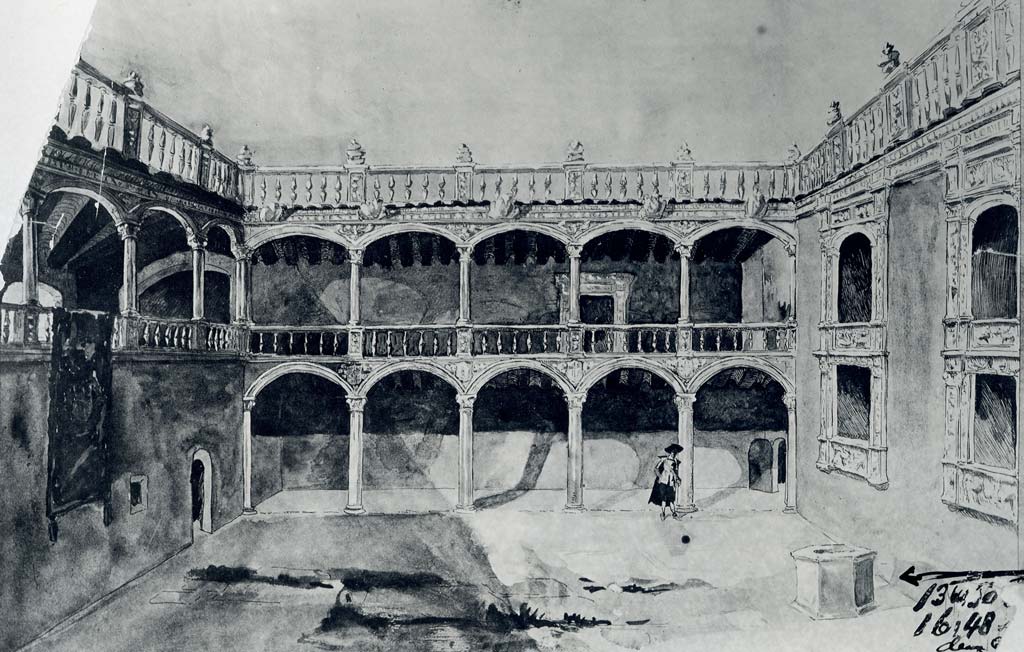
Watercolour from the 16th or 17th century showing what it looked like in its heyday (© MET, Metropolitan Museum of Art).
THE CASTLE VIEWPOINT
An unmistakable element both from the outside and from the inside is the large viewpoint with several arches with Gothic or late medieval decorative details. A lead and tile roof was used to waterproof this space. From the viewpoint there was an extraordinary panoramic view of the village, the fertile plain, the Muela mountain and the borderland of the old kingdom of Murcia with the castle of Jiquena in the distance. It is perhaps one of the most beautiful views in Almería.
It was a space linked to the courtyard and the palace outbuildings that would serve as a walk and recreation area for the inhabitants. Today it is a favourite place for travellers to take photos of their visit.
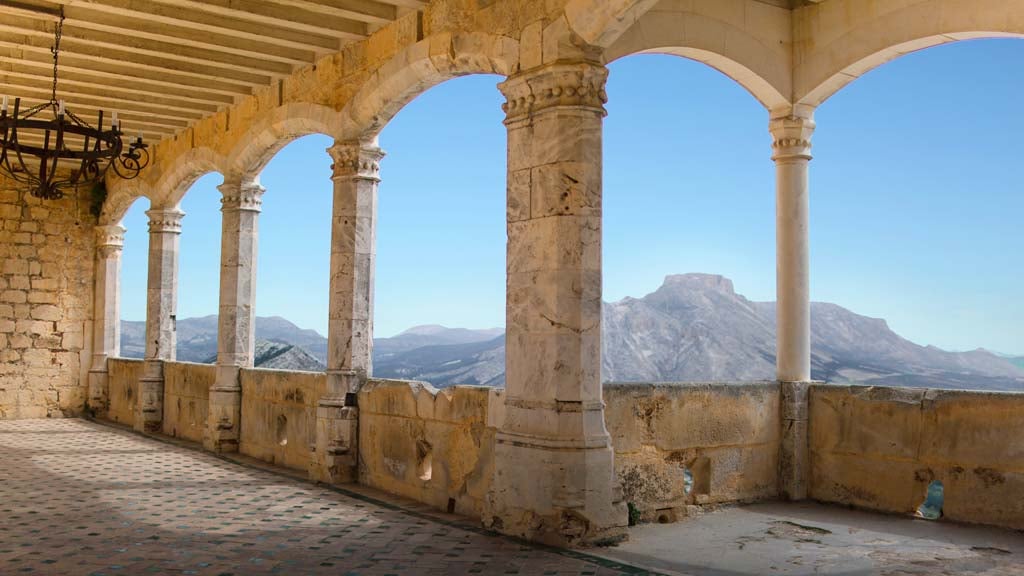
Mirador del Castillo Velez Blanco with views of La Muela, a unique mountain (© Turismo Andaluz www.andalucia.org).
HALL FRISES
The 11 long friezes sculpted in wood depicted Caesar’s triumphs in Gaul and the labours of Hercules. In both cases they are heroes of classical antiquity, so much to the taste of Renaissance men. It should be remembered that Pedro Fajardo was educated by Pedro Mártir de Anglería and had a considerable library in his own castle. These highly prized friezes, made according to classical models by Jacob of Strasbourg, were placed under the coffered ceilings of the Triumph and Mythology rooms, respectively.
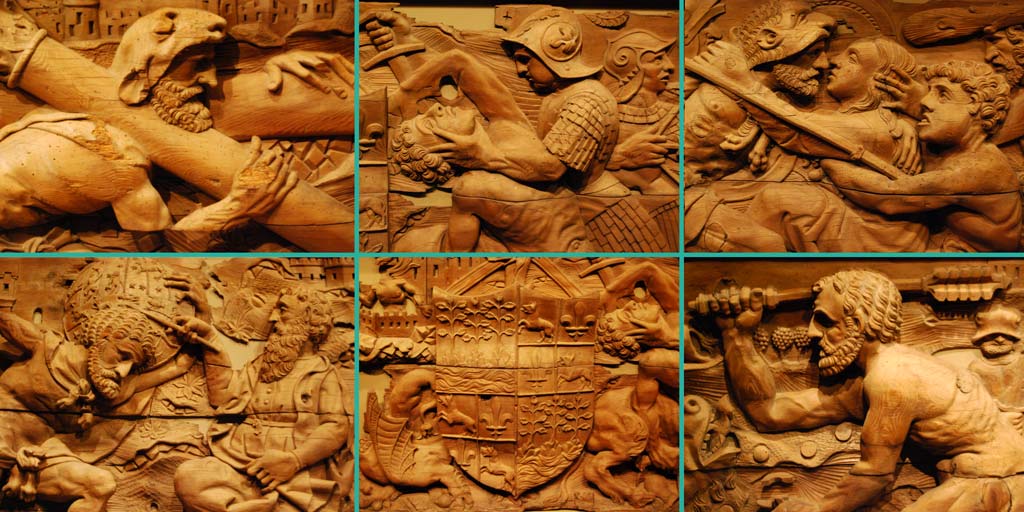
Wooden friezes of the Velez Blanco Castle in the Musée des Arts Décoratifs in Paris.
THE RUIN OF THE CASTLE OF VÉLEZ BLANCO
Pedro and his son, D. Luis Fajardo de la Cueva (1508-1574), who fought against the Moorish rebels, lived for long periods in the palace, but his descendants preferred the palace in the city of Murcia and the Madrid court. So the building and the administration of the manor remained in the hands of administrators. A few marquises visited it sporadically (Fernando Joaquín in the 17th century and Antonio Álvarez de Toledo in 1769), but most of them did not even know it. Even more so when the lineage of the Fajado family was extinguished(end of the 17th century) and the title passed to the Álvarez de Toledo family. The numerous reports we have from the end of the 18th century onwards are increasingly worrying: ruin, abandonment, closure, neglect… The few photos from the end of the 19th century are premonitory of its immediate disrepair.
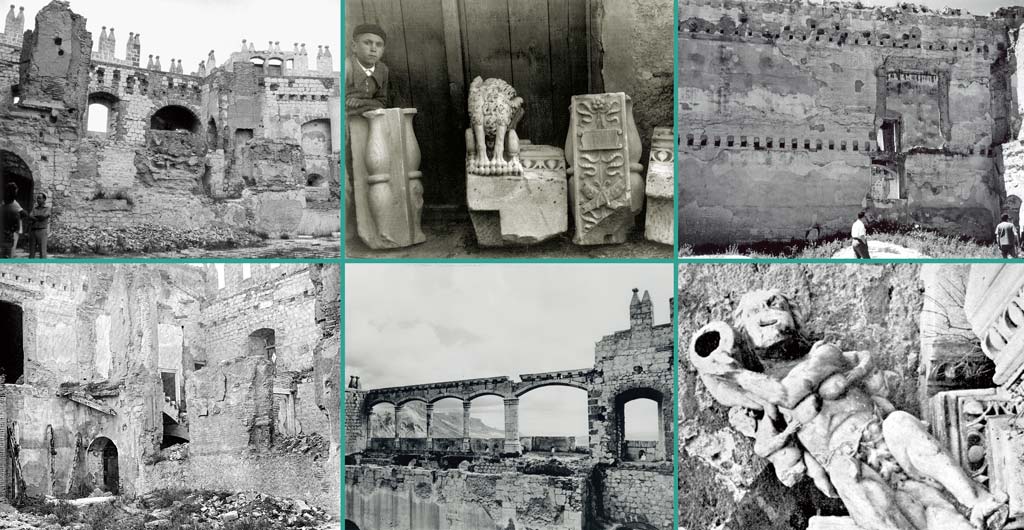
Old images of the castle of Velez Blanco in ruins (Photograph in “El Castillo de Velez Blanco, 1506-2006. Imagen y Memoria”).
THE SALE OF THE PATIO OF THE CASTLE OF VÉLEZ BLANCO
The Marquises’ desire for a monetary fund, the shrewdness of antique dealers and the lack of protective legislation all contributed to the acquisition of the wooden friezes by the Frenchman Golberg in 1903. The following year, armed with a good team of workers, he dismantled the building’s artistic treasures: the courtyard galleries, the windows, the staircase and the entrances to the noble salons. Numbered and ordered, they travelled by cart to the port of Cartagena. The alarm was raised there, but the stones continued on their way to Marseilles and, again by wagon, to the warehouses in Paris.
FROM FRANCE TO THE UNITED STATES
At the warehouses in the French capital, they were visited by various collectors and businessmen. For example, they were almost acquired by Archer Huntinton, the famous lover of Spanish art who created the Hispanic Society in America. In the end it was the married couple Georges and Florence Blumenthal who came to an agreement with Goldberg. Again they were packed up and moved to New York where the wealthy and cultured new owners were erecting a luxurious mansion on 5th Avenue. There, they would form part of the two-storey main hall, surrounded by the marbles of dozens of artistic pieces brought from all over the world.
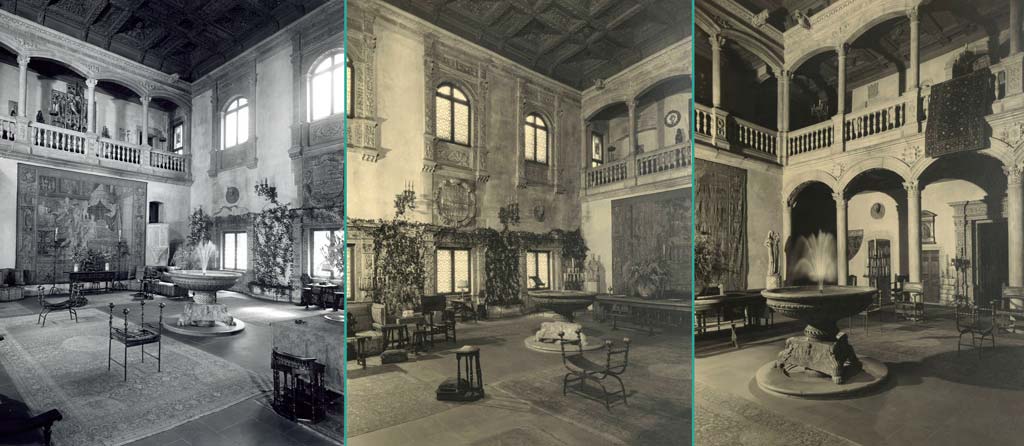
The house of Georges and Florence Blumenthal in New York with the marble decoration installed (Photograph in “The Castle of Velez Blanco, 1506-2006. Image and Memory”).
FROM THE BLUMENTHAL MANSION TO THE MET
Georges Blumenthal decided that the collections should be donated to the city’s Metropolitan Museum, of which he had been a patron. So in 1945 it was dismantled again and transported to the Metropolitan Museum, which took years to install it in one of its main galleries. Before that, in 1959, the researcher Olga Raggio (1926-2009) travelled to Spain to document the new installation, which was ready in 1964. At the same time O. Raggio wrote the best historical and artistic study of the courtyard.
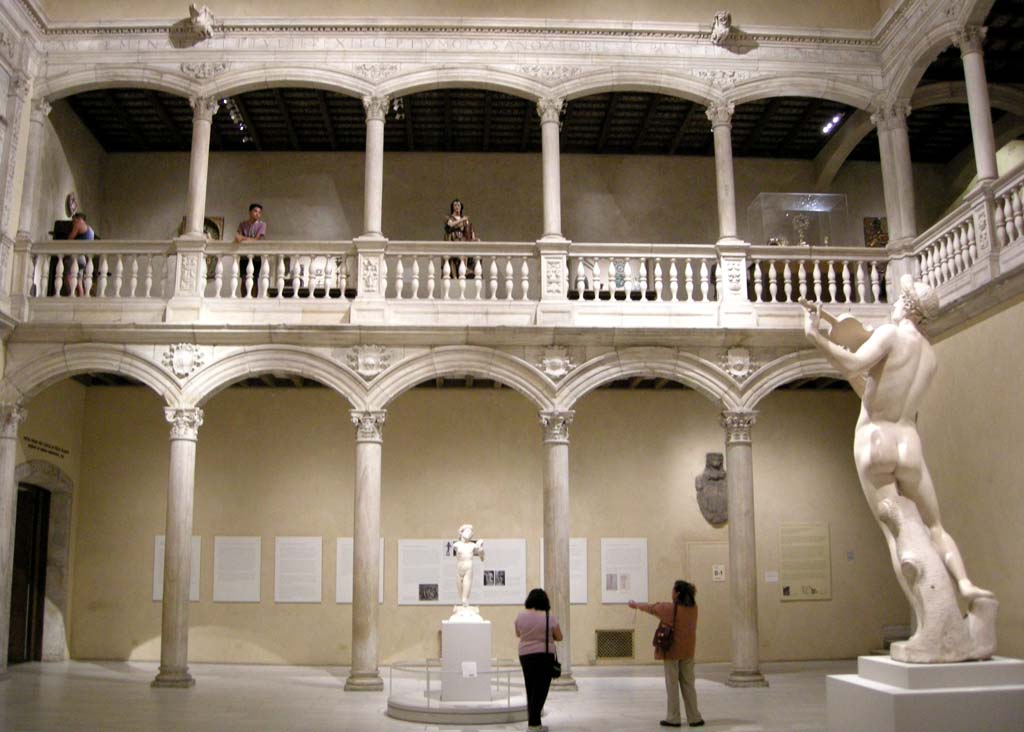
Courtyard of Velez Blanco Castle at the present-day Metropolitan Museum (© MET, Metropolitan Museum of Art) .
THE WORLDWIDE DISPERSION OF VARIOUS ARTISTIC WEALTH
The marble decoration of the courtyard of the castle of Vélez Blanco is preserved almost in its entirety at the Met in New York. However, there were other artistic pieces that were dispersed around the world.
Emile Peyre acquired the 11 wooden friezes for the Musée des Arts Décoratifs in Paris. They were forgotten in storage and rediscovered in 1992. When they were located, they were very deteriorated. They were restored, studied by Monique Blanc and some of them were put on permanent display.
The wooden coffered ceilings of the two halls were carved with decoration also inspired by Renaissance models. Since their removal at the beginning of the 20th century, their whereabouts were unknown. They were known to have been installed in the Blumenthal’s New York mansion in New York, but were later lost track of. Recent research has located them at the Instituto de Cultura Hispánica in Mexico City.
The pavement tiles were stolen and many ended up in private hands. The Miguel Guirao Museum in Vélez Rubio has some of them, but most of them are in the Instituto de Valencia de Don Juan, in Madrid.
The bronze door was eventually sold to a collector, but its current whereabouts are unknown.
THE RECOVERY OF THE NOBLE AND MALTREATED BUILDING
After the 1904 collapse, the fortress was badly damaged and in total ruin. Some scholars mourned its loss, but the first interventions for its cleaning and reconstruction began in the mid-1960s and lasted until the end of the 20th century. The Junta de Andalucía finally acquired it between 2005 and 2006. Although a 3D scan of the courtyard was carried out in New York, its reproduction in the castle of Vélez Blanco has not yet been tackled.
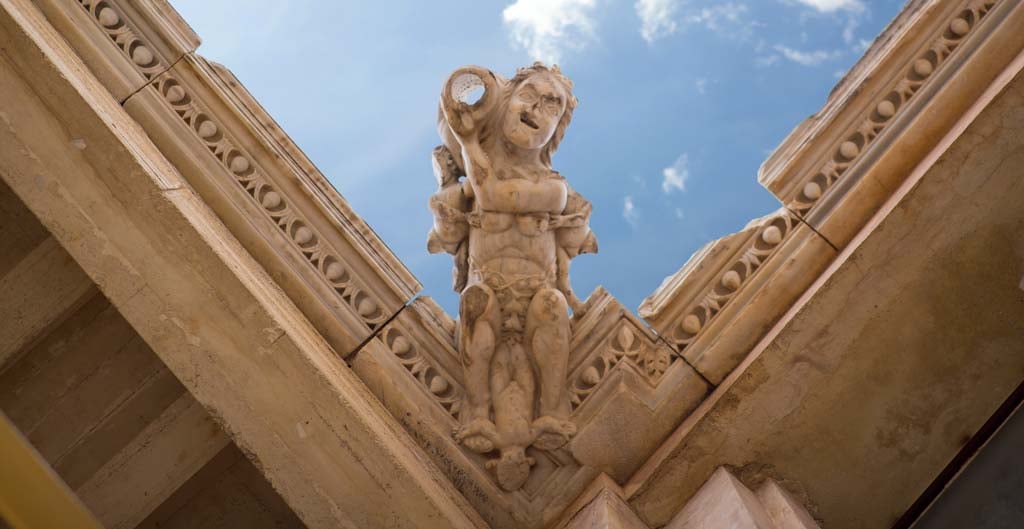
One of the original gargoyles used in the restoration of the Velez Blanco Castle (© Turismo Andaluz).
VISITING THE CASTLE OF VÉLEZ BLANCO
VIRTUAL VISIT TO THE PATIO OF VÉLEZ BLANCO CASTLE
The best way to get to know a place is to visit it, and if you can do it with a guide, even better. If you can’t do it now, we leave you this virtual reconstruction in 360 degrees where the decoration in New York is superimposed on the current state of the castle courtyard.
BEST TIME TO VISIT THE CASTLE
We always say spring and autumn, but there are few deciduous trees in the Vélez and winter is a fantastic time to visit. If you’re lucky you might even find the castle snow-covered.
But there is also the Vélez Blanco Renaissance and Baroque Music Festival in summer. It is a 19 year old festival where concerts are held inside the castle itself – Renaissance music in a Renaissance castle! But also in summer there is the Velez Blanco Renaissance and Baroque Music Festival.
HOW TO GET TO THE CASTLE
Whether you are coming from the east or west, you can get there via the A-92 motorway. At Vélez Rubio we leave the motorway and head towards Vélez Blanco. After 6 kilometres on a conventional road we arrive at Vélez Blanco.
If you are going to visit the castle, do not enter the village. Continue along the road as the castle of Vélez Blanco has a direct access. Some of the streets of Vélez Blanco are very narrow and are not worth the hassle of driving. However, they are well worth a visit on foot.
Vehicles can be left at the castle itself as there is a car park.
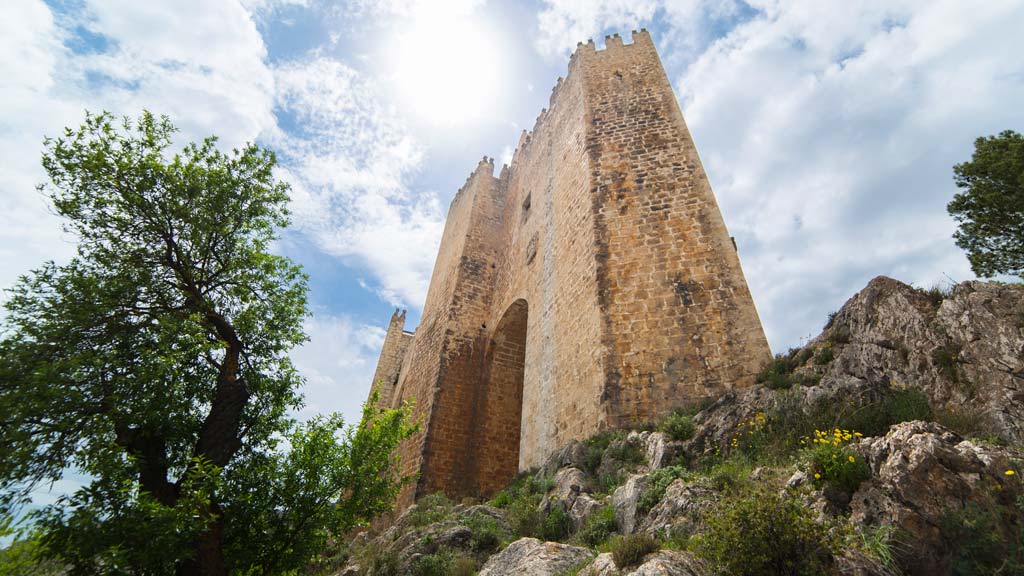
Almost impregnable walls crowned by singular battlements (© Turismo Andaluz).
TIME AND PRICE
The Castle of Vélez Blanco is open from Wednesday to Sunday and is closed on Mondays and Tuesdays. It has two opening hours, winter and summer.
- From May to September: from 10:00 to 14:00 and from 16:00 to 18:00
- October to April: 10:00 to 14:00 and 17:00 to 19:00
Admission is free
There is no guide or audio guide service.
As far as museography is concerned, there is only one room with information panels and a couple of models.
Contact telephone number: +34607415055.
VÉLEZ BLANCO. A VILLAGE WITH CHARM
You cannot leave without visiting the village of Vélez Blanco. It is perhaps the most outstanding village in the province of Almería and one of the most beautiful in Spain. Its appeal lies both in its exterior appearance, lying on a hillside overlooking the fertile plain, and in its interior due to the design of its streets, the abundance of fountains and the appearance of some of its large mansions.
The greatest pleasure of the town centre is strolling quietly through its streets, chatting with its neighbours, take photos from incredible perspectives and have an aperitif in one of its many bars. You should also visit some of its monuments: temples, hermitages, the Water Interpretation Centre or the Sierra María los Vélez Natural Park Visitor Centre.
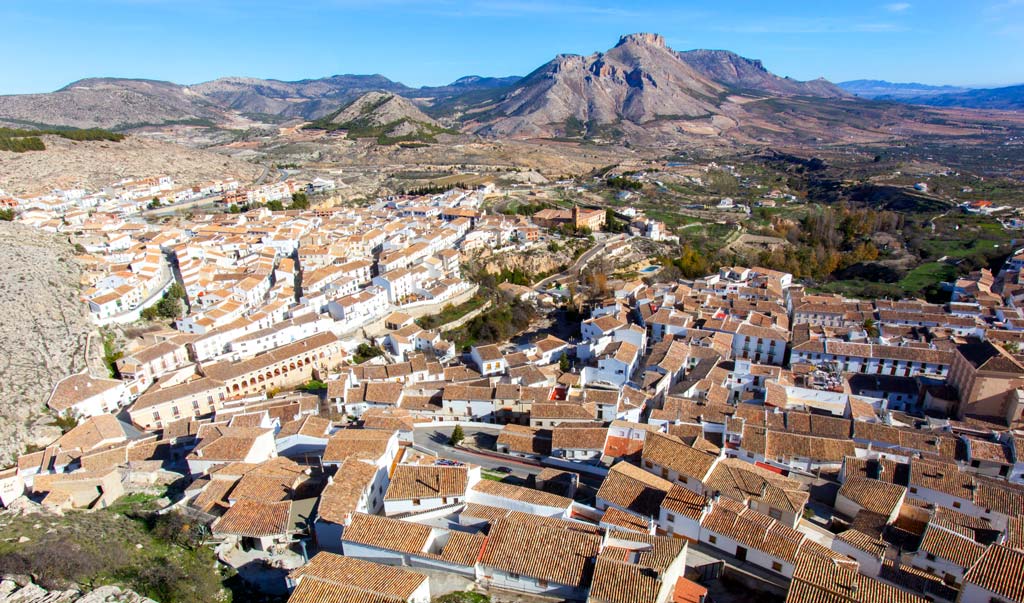
View of Vélez Blanco from the viewpoint of the castle, in the background La Muela (© Turismo Andaluz).
IGLESIA DE LA MAGDALENA
The old temple of Magdalena is located at the foot of the castle of the Marquis, just above the Morería quarter and surrounded by a multitude of unstudied medieval remains. It is apparently built on the site of the old Muslim mosque, although the current remains of its walls are clearly Christian. Its slender tower stands out, which houses four coats of arms of the lineages of the new settlers. It was once a parish church until the construction of the present church of Santiago Apóstol (16th century) in the Christian area, next to the Corredera, the main street of Vélez Blanco.
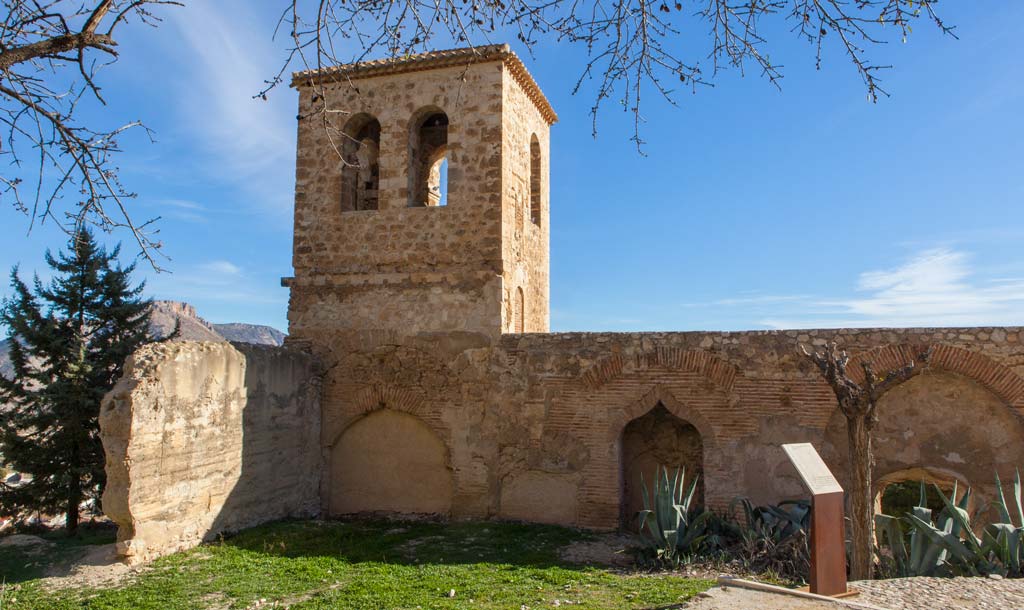
Iglesia de la Magdalena at the foot of the castle of Velez Blanco (© Turismo Andaluz).
And here the map so you can get to the castle of Velez Blanco and find some of the charming places of the village.
WILL YOU VISIT ANDALUSIA?
